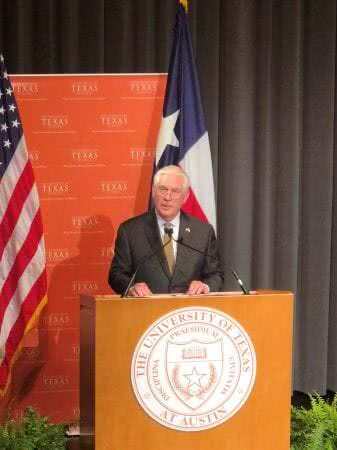
AUSTIN — The U.S. Department of State’s Bureau of Energy Resources (ENR) recently partnered with the University of Texas at Austin (UT Austin) on a workshop for Department officers and foreign government officials from Africa, Europe, and Latin America to illustrate how the “all-of-the-above” Texas energy system can serve as a model for countries looking to integrate all types of energy into their electricity grid.
“Visits by U.S. diplomats and foreign energy experts provide valuable academic and field work experience,” said Secretary of State Rex Tillerson on February 1st in Austin.
The U.S. Department of State’s energy collaboration with Texas is not new. A 25-year-old public-private partnership has provided Department officers in-depth training on energy issues in Houston. This partnership included American businesses, Rice University, the University of Houston, and trade associations such as the Petroleum Equipment and Services Association (PESA). The next training class starts February 5. The Department has also partnered with UT Austin to provide technical assistance to Mexico as the country deepens its regulatory capacity.
The Department also worked with the City of Houston as it successfully lined up international support for its successful bid to host the World Petroleum Congress in 2020, which will bring tourism and jobs to the United States.
Introducing the Texas energy model
When most people think of energy in Texas they think of oil and gas, and rightly so. Ever since the Spindletop Hill oil gusher in 1901, which ushered in the modern oil era, Texas has in many ways served as the unofficial capital of the world’s petroleum industry.
What is less well known, however, is that Texas is also the top producer of wind energy in the United States and a leader in integrating renewable energy into its electricity grid.
As stated in the National Security Strategy of the United States, an all-of-the-above energy model utilizes the broad spectrum of energy resources—coal, natural gas, petroleum, renewables, and nuclear— to “stimulate the economy and build a foundation for future growth.”
The Texas energy model is an example of a successful all-of-the-above approach to energy. Already a world leader in oil and gas production, Texas also produces roughly 20,321 megawatts of wind energy, more than all but five countries. Texas is also a major producer of solar power.
But integrating variable energy sources (such as wind and solar) with more traditional baseload energy sources (such as coal and natural gas) is not easy. As many countries have found, grid reliability sometimes suffers when countries try to integrate renewable energy sources. Texas has succeeded in this challenge for one unique reason: competition.
“When we say the Texas grid is competitive, what we mean is that it competes on a marginal price basis,” explained Michael Weber, Deputy Director of the Energy Institute at UT Austin. “The price of the next kilowatt hour is competing from one power plant to another. That model is now being adopted in other parts of the world and is looked to as an example of how to make an energy grid cheaper and cleaner at the same time.”
According to the Electric Reliability Council of Texas (ERCOT), which the Department group visited, on average electrical residential retail rates in Texas have declined since 2014, to prices as low as 4.5 cents per kilowatt-hour (kWh), compared to a nationwide average of 13.45 cents per kWh in 2016.
A view inside of the Electric Reliability Council of Texas (ERCOT) control room.
The Texas grid system is now the most competitive electrical market in North America, serving 90 percent of Texas’ total electrical load. The state’s deregulated power market has spurred innovation and competition among providers and created regulatory incentives, prompting billions of dollars in new transmission lines, which have facilitated the largest wind power generation in the United States.
ENR at UT Austin
Over the course of our week-long workshop in Austin, U.S. diplomats and visiting foreign energy experts learned the ins and outs of Texas’ unique and competitive energy model, from power system basics and transmission infrastructure to power markets and an introduction to the Texas grid system, alternative energy finance and development, and power sector efficiencies.
The workshop also included a number of visits to energy infrastructure sites in the greater Austin area, including hydropower and renewable energy facilities, a smart grid demonstration project, and a solar array farm.
The goal of the week-long workshop was simple: demonstrate to a delegation of U.S. diplomats and visiting foreign energy leaders that a diversified, competitive, and “all of the above” approach to energy works.
The U.S. Department of State welcomes its ongoing partnership with leading U.S. educational institutions and the private sector as it continues to demonstrate the U.S. model of energy to the world.
_______________
The Bureau of Energy Resources (ENR) leads the Department of State’s and U.S. government’s efforts to forge international energy policy, strengthen U.S. and global energy security, and respond to energy challenges from around the world that affect U.S. economic interests and national security.
ENR, together with several bureaus at the State Department, work to ensure economic and energy security for the United States and our allies; to open markets and remove barriers to energy development and trade; and to promote U.S. exports of energy resources, technologies, and services.
For more information, visit us at www.state.gov/e/enr/ or follow us on Twitter @EnergyAtState.
About the Author: Kaveh Farzad is a Presidential Management Fellow serving in the Bureau of Energy Resources, Office of Policy Analysis and Public Diplomacy at the U.S. Department of State.














